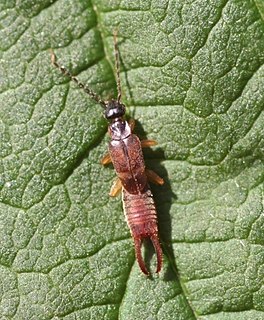
Earwigs make up the insect order Dermaptera. With about 2,000 species in 12 families, they are one of the smaller insect orders. Earwigs have characteristic cerci, a pair of forceps-like pincers on their abdomen, and membranous wings folded underneath short, rarely used forewings, hence the scientific order name, "skin wings". Some groups are tiny parasites on mammals and lack the typical pincers. Earwigs are found on all continents except Antarctica.

Forficula auricularia, the common earwig or European earwig, is an omnivorous insect in the family Forficulidae. The European earwig survives in a variety of environments and is a common household insect in North America. The name earwig comes from the appearance of the hindwings, which are unique and distinctive among insects, and resemble a human ear when unfolded; the species name of the common earwig, auricularia, is a specific reference to this feature. They are considered a household pest because of their tendency to invade crevices in homes and consume pantry foods, and may act either as a pest or as a beneficial species depending on the circumstances.

Forficulidae is a family of earwigs in the order Dermaptera. There are more than 70 genera and 490 described species in Forficulidae.
Oligonicella scudderi, common name Scudder's mantis or slender prairie mantid, is a species of praying mantis native to the southern United States. It is a small brown insect; the males can fly but the females are wingless.
Forficula iberica is a species of earwig in the family Forficulidae.

Forficula lesnei, or Lesne's earwig, is a species of earwig from Europe, particularly Britain. Compared to the common earwig, Lesne's earwig is shorter, with a body length around 8 mm (0.31 in). It can be found dwelling on the shrub Clematis vitalba.

Forficula lurida is a species of earwig in the family Forficulidae. It is mostly found in the Palaearctic realm, as well as parts of the Afrotropical realm.

Forficula smyrnensis is a species of earwig in the family Forficulidae. It is mostly found in the Palearctic realm.

Forficula is a genus of earwigs in the family Forficulidae. The best known species is Forficula auricularia.

Palaeovespa is an extinct genus of wasp in the Vespidae subfamily Vespinae. The genus currently contains eight species, five from the Priabonian stage Florissant Formation in Colorado, United States two from the middle Eocene Baltic amber deposits of Europe. and one species from the late Paleocene of France.

Labia minor, the lesser earwig or small earwig, is a species of earwig. It is widespread globally in temperate climates, preferring warm locations such as compost heaps in parts of its range. It is 4–7 mm long, including the pincer, and chocolate brown in color.
Anthidium scudderi is an extinct species of mason bee in the Megachilidae genus Anthidium. The species is solely known from the late Eocene, Chadronian stage, Florissant Formation deposits in Florissant, Colorado, USA. Anthidium scudderi is one of only four extinct species of mason bees known from the fossil record, and with Anthidium exhumatum, one of two species from the Florissant Formation.
Anthidium exhumatum is an extinct species of mason bee in the Megachilidae genus Anthidium. The species is solely known from the late Eocene, Chadronian stage, Florissant Formation deposits in Florissant, Colorado, USA. Anthidium exhumatum is one of only four extinct species of mason bees known from the fossil record, and with Anthidium scudderi, one of two species from the Florissant Formation.

Euploea camaralzeman is an Indomalayan species of danaine butterfly.

Lestes forficula, the rainpool spreadwing, is a species of spreadwing in the damselfly family Lestidae. It is found in the Caribbean Sea, Central America, North America, and South America.
Bembidion scudderi is a species of ground beetle in the family Carabidae. It is found in North America.

Melanoplus scudderi, or Scudder's short-wing grasshopper, is a species of spur-throated grasshopper in the family Acrididae. It is found in North America.

Stylurus scudderi, the zebra clubtail, is a species of clubtail in the dragonfly family Gomphidae. It is found in North America.
Eremopedes scudderi is a species of shield-backed katydid in the family Tettigoniidae. It is found in North America.












